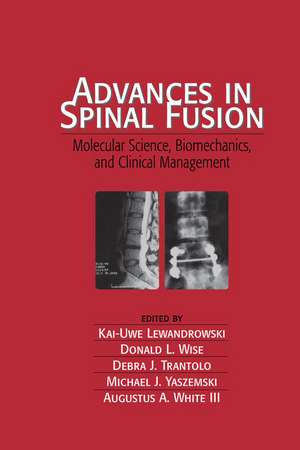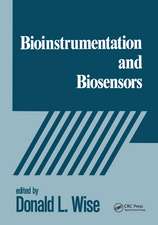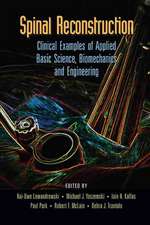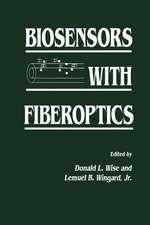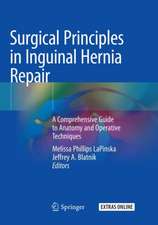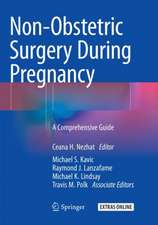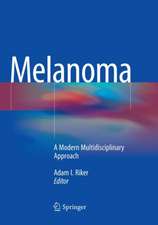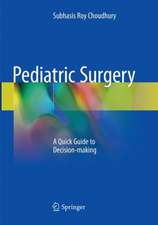Advances in Spinal Fusion: Molecular Science, BioMechanics, and Clinical Management
Autor Kai-Uwe Lewandrowskien Limba Engleză Hardback – 21 oct 2003
Preț: 2921.68 lei
Preț vechi: 3563.02 lei
-18% Nou
Puncte Express: 4383
Preț estimativ în valută:
559.08€ • 597.83$ • 466.14£
559.08€ • 597.83$ • 466.14£
Carte tipărită la comandă
Livrare economică 17 aprilie-01 mai
Preluare comenzi: 021 569.72.76
Specificații
ISBN-13: 9780824743109
ISBN-10: 0824743105
Pagini: 824
Dimensiuni: 178 x 254 x 43 mm
Greutate: 1.68 kg
Ediția:New.
Editura: CRC Press
Colecția CRC Press
ISBN-10: 0824743105
Pagini: 824
Dimensiuni: 178 x 254 x 43 mm
Greutate: 1.68 kg
Ediția:New.
Editura: CRC Press
Colecția CRC Press
Public țintă
ProfessionalCuprins
Preface 1 Reduction and Fixation of Sacroiliac Joint Dislocation by the Combined Use of SI Pedicle Screws and an Iliac Rod 2 Percutaneous Vertebroplasty in the Treatment of Osteoporotic Fractures 3 Biomechanics of Vertebroplasty 4 Kyphoplasty and Vertebroplasty for the Treatment of Painful Osteoporotic Vertebral Compression Fractures 5 Carbon Fiber-Reinforced Polymer Implants for Spinal Fusion: Biomechanical and Clinical Advantages of a New Material 6 Stand-Alone Anterior Lumbar Interbody Fusion Constructs: Effect of Interbody Design, Bone Graft, and Bone Morphogenetic Protein on Clinical and Radiographic Outcomes 1 Overcoming Chemical Inhibition of Spine Fusion 8 Use of a Cloned Osteoprogenitor Cell in Spinal Fusion 9 Axially Loaded Computer Tomography and Magnetic Resonance Imaging of the Lumbar Spine 10 Experience with OP-1 in a Rabbit Model of Lumbar Fusions 11 Structure and Function of Normal, Degenerate, and Surgically Fixed Spinal Segments 12 A Quantitatively Unstable Model to Evaluate the Biological Effects of Mechanical Forces on Spine Fusion 13 Ankylosing Spondylitis and Spinal Complications 14 Atlantoaxial Transarticular Screw Fixation: Indication, Technique, Risks, and Pitfalls 15 Biomechanics of Artificial Discs 16 Comparison of the Leukotactic Properties of Nucleus Pulposus, Anulus Fibrosus, and Cartilage Following Subcutaneous Injection in Pigs 17 Advances in Bone Graft Substitutes in Spinal Fusion 18 Titanium Mesh Cage in Spinal Reconstruction Surgery: Biomechanics and Clinical Application 19 Posterior Lumbar Interbody Fusion Using the Brantigan I/F Cage 20 SF-36 Health Status and Oswestry Disability Index in Worker’s Compensation Patients with Neck Pain 21 Interbody Fusion in the Elderly 22 Choice of Anterior and Posterior Thoracolumbar Spinal Implants 23 Spondylotic Cervical Myelopathy: Clinical Aspects 24 Autogenous Free Fat Grafts After Posterior Lumbar Surgery 25 In Vitro Stability of Cervical Spine Cages 26 In Vivo Performance of Cervical Spine Cages 27 Autologous Growth Factors and Progenitor Cells as Effective Components in Bone Grafting Products for Spine 28 Process of Lumbar Spinal Degeneration: Interrelationships Between Disc Degeneration and Facet Joint Osteoarthritis 29 Relationships Between Lumbar Sagittal Alignment and Clinical Outcomes After Decompression and Posterolateral Spinal Fusion for Degenerative Spondylolisthesis 30 Histological Findings in Revision Surgery of Instrumented Spine Fusion with the Use of Coralline Hydroxy apatite 31 New Developments in Spinal Cord Monitoring 32 The Physical Properties and Biocompatibility of Plasma-Sprayed Hydroxyapatite Coating 33 Biomechanical Efficacy of Vertebroplasty and Kyphoplasty 34 Bioactive Bone Cement for the Treatment of Osteoporotic Vertebral Compression Fracture 35 Advances in Technology and Spinal Fusion: A Clinician’s Perspective 36 Replacement of Autograft with BMP for Spinal Arthrodesis: Future Perspectives Following Recent Research 37 Occipitocervical Fusion for Rheumatoid Arthritis Patients with Myelopathy 38 Validity of a Bioactive Ceramic Spacer in Posterior Lumbar Interbody Fusion with Studies of the Stability of the Pedicle Screw for the Osteoporotic Spine In Vivo and In Vitro 39 Thoracic Pedicle Screws: Biomechanical Considerations of the Extrapedicular Approach 40 Two-Cage Reconstruction Versus Single Mega-Cage or Dual Nested Cages for Lumbar Interbody Fusion 41 Spontaneous Remission of Intervertebral Disc Hernia and Responses of Surrounding Macrophages 42 Gene Expression Profiling During Osteochondrogenic Events in the Spinal Region: Use in the Development of Promising Spinal Fusion 43 Cells, Signals, and Scaffolds: The Future of Spinal Fusion 44 Roentgen Stereometric Analysis: A Novel In Vivo Method to Assess Spinal Fusion 45 The Morbidity of Autogenous Bone Graft Donation 46 Loads on an Internal Spinal Fixation Device Measured In Vivo 47 New Anterior Cervical Instrumentation Systems Combining Intradiscal Cage with Integrated Plate: Biomechanics and Clinical Applications 48 Improvement of Pedical Screw Fixation with Hydroxy apatite Coating 49 Multilevel Cervical Decompression and Reconstruction 50 Decision Support Tools in Spinal Surgery: Artificial Neural Networks and Predictive Modeling 51 Porous Tantalum for Spinal Interbody Fusion 52 Advances in Spinal Fusion
Notă biografică
Kai-Uwe Lewandrowski, Cleveland Clinic Cleveland, Ohio, U.S.A. Donald L. Wise, Northeastern University Boston, and Cambridge Scientific, Inc. Cambridge, Massachusetts, U.S.A. Debra J. Trantolo, Cambridge Scientific, Inc. Cambridge, Massachusetts, U.S.A. Michael J. Yaszemski, Mayo Clinic Rochester, Minnesota, U.S.A. Augustus A. White III, Beth Israel Deaconess, Medical Center Boston, and Harvard Medical School Boston, Massachusetts, U.S.A.
Descriere
Advances in Spinal Fusion reveals a new generation of materials and devices for enhanced operations in spinal fusion. This reference showcases emerging research and technologies in areas such as biodegradable implants, drug delivery, stem cell isolation and transfection, cell encapsulation and immobilization, and the design of 2D and 3D scaffolds for cells. It captures a cascade of innovations crucial to increased healing and decreased morbidity in spinal fusion methods and mechanics and addresses current standards in analytical methodology and quality control, it describes the selection of biomaterials for improved biocompatibility, biostability, and structure/function relationships.
